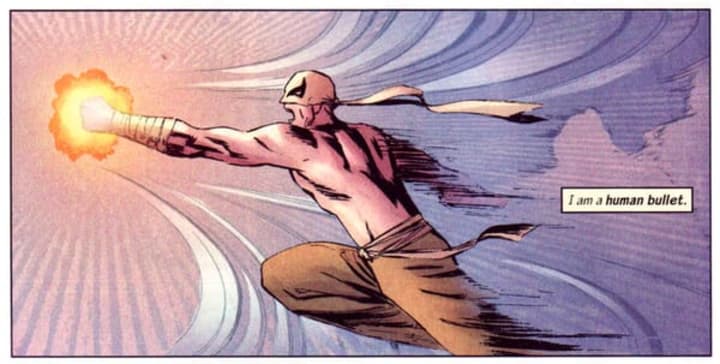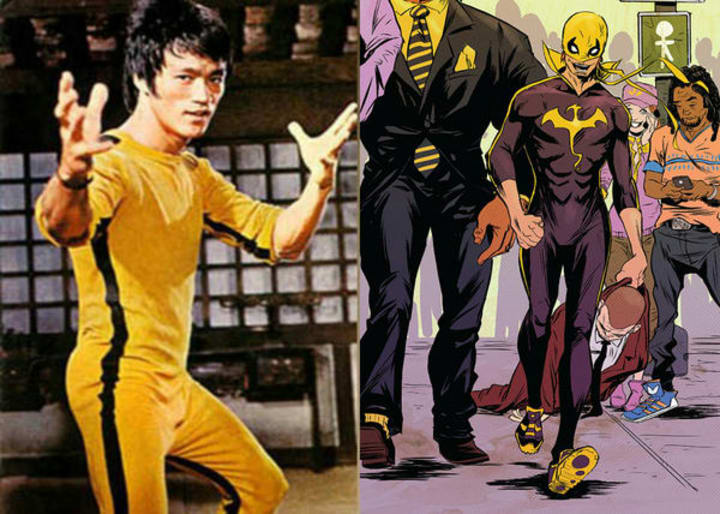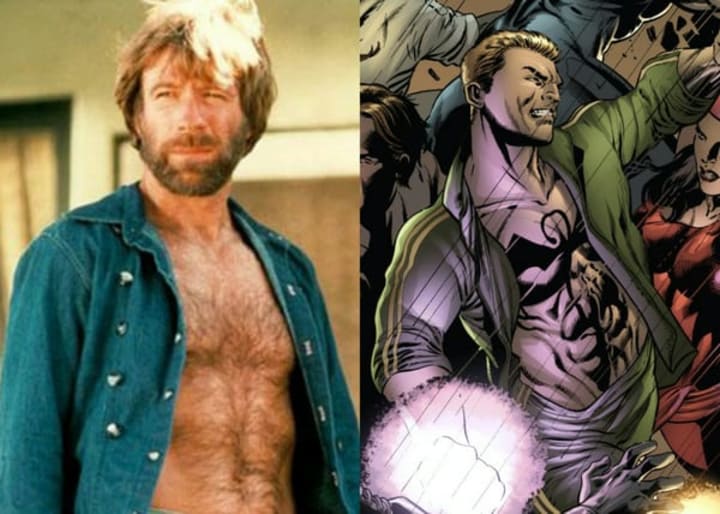Unlocking the Iron Fist: The Real-World Science Behind a Powerful Punch
The Iron Fist, and how to deliver the world's most powerful punch, according to science.

“I am the Iron Fist. I hold back the storm when nothing else can.”– Danny Rand
The world’s strongest punch requires the least muscle pullback, movement, or physical strain — instead of simply tossing a jab by flinging your fist forward, a powerful punch involves throwing your entire body against your target, relying on the full force of it to break boards with ease, or send opponents flying.

Even in magical Kamar-Taj, punching is key. [Credit: Doctor Strange, 2016. Marvel Studios.]
It may sound like something out of a science-fiction movie or a Hong Kong martial arts flick, but this is pure science (believe it or not), with practical, real-world applications in both ancient and modern-day martial arts. In fiction and IRL, only two people are known to have successfully traversed the impossible when it comes to dealing explosive punches. The first, in fiction, being the Iron Fist, armed with the ability to sink and kill dragons, and the second, in real life, being the man who took down the likes of Chuck Norris with successive punches — Bruce Lee.
Danny Rand’s Real-World Influences As The Iron Fist

A living weapon. [Credit: Iron Fist, Marvel Comics]
It’s no question who creators Roy Thomas and Gil Kane were inspired by when they came up with the character of Daniel Rand-K’ai and his backstory as both the Iron Fist and co-owner of Rand Enterprises. The legend of the Iron Fist, after all, was first introduced in the ‘70s during the resurgence of the kung fu cinematic era, at a time when the likes of Bruce Lee and #ChuckNorris were considered household favorites.
In physicality, Danny was the quintessential comic book Chuck Norris; in style and belief, he was always naturally Bruce Lee.

Jumpsuit brothers! [Bruce Lee and the Iron Fist]
From the color of his suit, to his fighting style and everyday philosophy, #DannyRand is everything Bruce Lee aspired to. The Iron Fist believed in the very same teachings Lee had popularized in his prime and applied to his training — including, among others, the unwritten jeet kune do dogma that to be an effective combatant, one must move and think like water, and the teaching that “working too hard” doesn’t work. Instead, relax, take a deep breath, and focus on your “internal force,” rather than the “external.” Danny Rand also makes frequent use of t'ai chi ch'uan and other indigenous Chinese kung fu styles in training — a trait one can only attribute at that time to Bruce Lee.

Body twins. [Chuck Norris and the Iron Fist]
Similarly, Chuck Norris is as much a living contradiction as Danny Rand, both of them being white, blond males — outsiders to their Asian mentors and training partners, essentially — with martial arts skills rivaling, or even sometimes exceeding, the best that Asia has to offer.
One particular technique that is so crucially pivotal to the #IronFist’s way of fighting, however, is neither rooted in the West or inspired by Chuck Norris — the Iron Fist’s most powerful punch that can crush concrete, break blades, and kill dragons is based on Bruce Lee’s most popular technique — the “one-inch punch," also known for crushing solid surfaces, breaking boards, and effortlessly flinging opponents away.
Contrary to popular notion, the legendary one-inch punch “that could break boards and men” was not #BruceLee’s original creation; the technique can be traced as far back as the earliest forms of Southern Chinese martial arts, where kung fu practitioners were trained to harness the power of their fists to gain the upper hand in battle. Styles like wing chun or the Fujian white crane were made specifically for punching, hand-chopping, and close combat fighting.
As most martial arts enthusiasts probably know, one of Bruce Lee’s most prominent mentors was Ip Man himself, a grandmaster of #wingchun, who then taught young Bruce everything he knew about defending with the hands and arms, and close combat martial arts. Lee’s legendary jab was eventually developed, and honed, as a result of that training.
The one-inch punch was first demonstrated in front of a big audience in 1964 by Bruce Lee during the Long Beach International Karate Championships. Since then it has been performed, demoed, and copied countless times, often with a board, sometimes in front of a person holding a board, by Lee’s #JeetKuneDo students, and other ardent #martialarts practitioners.
Science Behind The Technique
The one-inch punch (or six-inch punch, as it is sometimes known, because it can be performed at a range of zero to six inches) is a close-combat kung fu technique that relies almost exclusively on momentum to work; unlike most other punches, however, the momentum does not begin in the shoulders or the wrist, or even the hips and midsection — believe it or not, the power starts all the way from the base of your foot.
As you release the pent-up kinetic force from your entire body, and in one fluid motion throw it all forward, the power should quickly travel up your leg, up your hips, through your shoulder and down your arm, until you finally snap your wrist back, crashing the lower two knuckles on your fist against the target.
Like most other martial arts techniques, the one-inch punch begins with correct form, with the torso straight, the knees slightly bent and toes pointed away from each other. The foot equivalent to the hand doing the punching should be placed forward, with the toes more or less pointed between the target’s feet. The back leg and foot should be exactly behind, ready to spring forward as soon as the punch is released.
Similarly, the punching arm should be raised, stretched and bent at a slight 45-degree angle, with the hand in question closed gently into a fist. Particular emphasis, however, should be taken to make sure the entire body — especially the arm down to the hand — remains completely relaxed and flexible; that way, when the whole body finally stiffens, turns, and snaps, the impact force is all the greater.
To properly execute the one-inch punch, the user needs to quickly turn the front ankle and the hips forward, snapping the wrist back at the last second for maximized impact force. The front leg should then immediately straighten as the power is released, with the back foot serving as support by adding to the total impact strength and further flinging the target forward. As you can see, the technique is more than just building momentum; it also concerns building just enough rotational strength to work properly.
So the one-inch punch involves throwing the full force of your entire body against your target, instead of simply flinging your fist at them, like what most people might assume. To perform this accurately, optimal rotational force is key; essentially, the higher the velocity (a.k.a. the faster it is), the more destructive the overall punch. The idea, quite simply, is to use the momentum from your ankles all the way up to your hips, shoulder, and wrist to generate explosive amounts of impact force at very close distances, breaking boards — and sometimes men — immediately upon contact. Overall, the technique is less about brawn (or raw strength, like how Saitama manages his punches), and more about brain power, speed and timing.
Once the punch is thrown, it’s equally important to pull back away from the target as soon as possible; according to Stanford biomedical researcher Jessica Rose, this allows the user to shorten the impact time of the punch, compressing the force and combined power of all the muscles in the body into a small space, thereby making the resulting blow even more powerful. This is how Bruce Lee was able to fling opponents across a room with just a single jab; his punches are pretty much the human equivalent of pushing a tiny grenade against someone’s chest.
Take note that the technique relies on mass times velocity specifically, rather than muscle speed and strength; the latter is voluntarily generated by us, mentally, when we will our limbs to move forward and back — that’s not the case here with the one-inch punch. Essentially, here you are just letting your body throw itself against your target; you’re not making it throw itself forward intentionally or forcing the muscles voluntarily in any way.
This is what I meant earlier when I said the punch needs very little movement or pullback to work; the moment you pull your fist back, or move a little more than a fraction of an inch than what is necessary, the technique is ruined. You’d have lost punishing power right away before you can even go as far as touching your target.
About the Creator
Dylan Balde
Secretly Dead and Strange, writes for a living. Moonlights as a cat-obsessed dork and innocuously wrapped human nitroglycerin. My life is an everyday Westchester incident. 💀 @dylanbalde






Comments
There are no comments for this story
Be the first to respond and start the conversation.